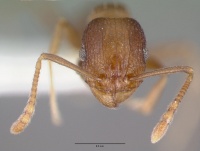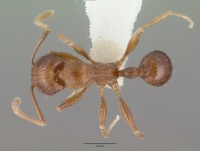Tetramorium praetextum
| Tetramorium praetextum | |
|---|---|

| |
| Scientific classification | |
| Kingdom: | Animalia |
| Phylum: | Arthropoda |
| Class: | Insecta |
| Order: | Hymenoptera |
| Family: | Formicidae |
| Subfamily: | Myrmicinae |
| Tribe: | Crematogastrini |
| Genus: | Tetramorium |
| Species: | T. praetextum |
| Binomial name | |
| Tetramorium praetextum Bolton, 1980 | |
Known only from the type collection. This record does not specify the habitat or collecting conditions.
Identification
Bolton (1980) - Of the 13 species presently known in the setigerum-group, T. praetextum and its two closest allies Tetramorium doriae and Tetramorium gracile form a small complex characterized by their feebly developed frontal carinae, weakly armed propodeum and relatively long petiole nodes. Of the three T. praetextum is isolated by its lack of outstanding hairs on the sides of the head behind the eyes, the presence of faint basigastral sculpture, the relatively small eyes (0.24-0.25 x HW in T. praetextum as opposed to 0.29-0.33 x HW in T. doriae and T. gracile), and the absence of elongate anteriorly curved hairs on the ventral surface of the head.
Keys including this Species
Distribution
Distribution based on Regional Taxon Lists
Afrotropical Region: Namibia (type locality).
Distribution based on AntMaps
Distribution based on AntWeb specimens
Check data from AntWeb
Countries Occupied
| Number of countries occupied by this species based on AntWiki Regional Taxon Lists. In general, fewer countries occupied indicates a narrower range, while more countries indicates a more widespread species. |

|
Estimated Abundance
| Relative abundance based on number of AntMaps records per species (this species within the purple bar). Fewer records (to the left) indicates a less abundant/encountered species while more records (to the right) indicates more abundant/encountered species. |

|
Biology
Castes
Nomenclature
The following information is derived from Barry Bolton's Online Catalogue of the Ants of the World.
- praetextum. Tetramorium praetextum Bolton, 1980: 282, fig. 52 (w.) NAMIBIA.
Unless otherwise noted the text for the remainder of this section is reported from the publication that includes the original description.
Description
Worker
Holotype: TL 3.1, HL 0.78, HW 0.66, CI 85, SL 0.69, SI 105, PW 0.46, AL 0.92. Paratypes (5 measured): TL 3.0-3.3, HL 0.78-0.82, HW 0.65-0.68, CI 82-85, SL 0.68-0.72, SI 103-106, PW 0.44-0.48, AL 0.88-0.94. Maximum diameter of eye 0.16-0.17, about 0.24-0.25 x HW.
Mandibles longitudinally striate. Anterior clypeal margin entire, without a median notch or impression. Frontal carinae present but very weakly developed throughout their length, hardly more than a feebly raised line and only slightly more strongly developed than the other cephalic sculpture. Frontal carinae close together, their maximum separation about 0.42 x HW, slightly divergent posteriorly and ending approximately midway between the level of the posterior margins of the eyes and the occipital margin. Antennal scrobes absent; scapes quite long, SI > 100. Eyes moderate, their maximum diameter 0.16, about 0.24 x HW. Alitrunk in profile with the metanotal groove weakly impressed. Propodeum armed with a pair of minute denticles which are directed more or less vertically. Metapleural lobes triangular and acute apically, very obviously much larger than the propodeal denticles. Petiole in profile with a long anterior peduncle and a roughly rectangular node; the node with antero- and posterodorsal angles blunted and having the dorsal surface shallowly convex and slightly longer than the height of the tergal portion. In dorsal view the petiole node is slightly longer than broad, with evenly but shallowly convex sides so that the maximum width of the node is at the midlength. Dorsum of head with a fine, inconspicuous punctulate ground-sculpture, almost effaced in places, and with a number of widely spaced, weak, irregular longitudinal rugulae. Median portion of occipital region without a rugoreticulum but the occipital corners on each side with a weak reticulum developed. Dorsal alitrunk finely and superficially longitudinally rugulose, the rugulae feeble and the spaces between them densely finely punctulate, especially on the promesonotum. Dorsal surfaces of petiole and postpetiole with a number of extremely fine longitudinal rugulae and lightly punctulate spaces between them. Base of first gastral tergite lightly but densely punctulate or faintly shagreened. Dorsal surfaces of head and body with scattered standing hairs which are very short, the longest of those on the alitrunk (on the anterior pronotum) distinctly much shorter than the diameter of the eye. Hairs absent from the sides of the head behind the eyes. Appendages only with fine, appressed pubescence. Colour mid-brown.
Paratypes: As holotype but colour varying from mid to dark brown.
Type Material
Holotype worker, South West Africa: 10 miles [16 km] S. of Okaukuejo, 14.v.1958, 1100 m (E. S. Ross & R. E. Leech) (California Academy of Sciences). Paratypes, 5 workers with same data as holotype (California Academy of Sciences; The Natural History Museum; Museum of Comparative Zoology).
References
References based on Global Ant Biodiversity Informatics
- Bolton B. 1980. The ant tribe Tetramoriini (Hymenoptera: Formicidae). The genus Tetramorium Mayr in the Ethiopian zoogeographical region. Bulletin of the British Museum (Natural History). Entomology 40: 193-384.

